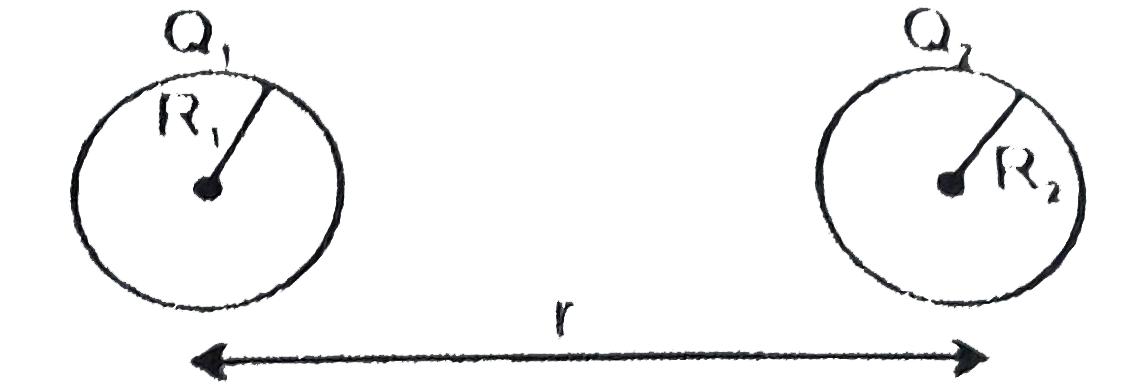Two small charged spheres contain charge +q1and+q2 respectively. A charge dq is removed from sphere carrying charge q1 and is transferred to the other. Find charge on each sphere for maximum electric force between them.
The correct Answer is:12(q1+q2)
To find the charge on each sphere for maximum electric force between them after transferring a charge dq from sphere 1 (with charge q1) to sphere 2 (with charge q2), we can follow these steps:
Step 1: Define the Charges After Transfer
After transferring a charge dq from sphere 1 to sphere 2, the new charges on the spheres will be:
- Charge on sphere 1: q′1=q1−dq
- Charge on sphere 2: q′2=q2+dq
Step 2: Write the Expression for Electric Force
The electric force F between the two spheres can be expressed using Coulomb's Law:
F=kq′1q′2r2
Substituting the new charges:
F=k(q1−dq)(q2+dq)r2
Step 3: Expand the Force Expression
Expanding the expression:
F=k(q1q2+q1dq−q2dq−dq2)r2
This can be simplified to:
F=kq1q2r2+k(q1−q2)dqr2−kdq2r2
Step 4: Differentiate the Force with Respect to dq
To find the value of dq that maximizes the force, we differentiate F with respect to dq:
dFdq=k(q1−q2)r2−k2dqr2
Setting the derivative equal to zero for maximization:
0=(q1−q2)r2−2dqr2
This simplifies to:
q1−q2=2dq
Step 5: Solve for dq
From the equation q1−q2=2dq, we can solve for dq:
dq=12(q1−q2)
Step 6: Find the Charges on Each Sphere
Now, substitute dq back into the expressions for the charges on each sphere:
- Charge on sphere 1:
q′1=q1−dq=q1−12(q1−q2)=12(q1+q2)
- Charge on sphere 2:
q′2=q2+dq=q2+12(q1−q2)=12(q1+q2)
Conclusion
Thus, for maximum electric force between the two spheres, the charges on each sphere will be:
q′1=12(q1+q2)andq′2=12(q1+q2)
After transferring a charge dq from sphere 1 to sphere 2, the new charges on the spheres will be:
- Charge on sphere 1: q′1=q1−dq
- Charge on sphere 2: q′2=q2+dq
The electric force F between the two spheres can be expressed using Coulomb's Law:
F=kq′1q′2r2
Substituting the new charges:
F=k(q1−dq)(q2+dq)r2
Expanding the expression:
F=k(q1q2+q1dq−q2dq−dq2)r2
This can be simplified to:
F=kq1q2r2+k(q1−q2)dqr2−kdq2r2
To find the value of dq that maximizes the force, we differentiate F with respect to dq:
dFdq=k(q1−q2)r2−k2dqr2
Setting the derivative equal to zero for maximization:
0=(q1−q2)r2−2dqr2
This simplifies to:
q1−q2=2dq
From the equation q1−q2=2dq, we can solve for dq:
dq=12(q1−q2)
Now, substitute dq back into the expressions for the charges on each sphere:
- Charge on sphere 1:
q′1=q1−dq=q1−12(q1−q2)=12(q1+q2)
- Charge on sphere 2:
q′2=q2+dq=q2+12(q1−q2)=12(q1+q2)
Thus, for maximum electric force between the two spheres, the charges on each sphere will be:
q′1=12(q1+q2)andq′2=12(q1+q2)
Topper's Solved these Questions
- BOOK - PRADEEPCHAPTER - ELECTROSTATICSEXERCISE - FILL IN THE BLANKS8videos
ELECTROSTATICS
- BOOK - PRADEEPCHAPTER - ELECTROSTATICSEXERCISE - PROBLEMS FOR PRACTICE8videos
ELECTROSTATICS
- BOOK - PRADEEPCHAPTER - ELECTROSTATICSEXERCISE - VALUE BASED QUESTIONS7videos
ELECTROSTATICS
- BOOK - PRADEEPCHAPTER - ELECTRONIC DEVICESEXERCISE - Fill in the Blanks1videos
ELECTRONIC DEVICES
- BOOK - PRADEEPCHAPTER - MAGNETIC EFFECT OF CURRENT AND MAGNETISMEXERCISE - Competition Focus (Multiple Choice Questions)2videos
MAGNETIC EFFECT OF CURRENT AND MAGNETISM
Similar Questions
Two non-conduction hollow uniformly charged spheres of radil R1 and R2 with charge Q1 and Q2 respectively are places at a distance r. Find out total energy of the system.
 View Solution
View SolutionTwo identical conduction spheres, one having an initial charge +Q and the other initially uncharged, are brought into contact.
(a) What is the new charge on each sphere?
(b) While the spheres are in contact, a positively chaged rod is moved close to one sphere, causing a redistribution of hte charges on the two spheres so the charge on hte sphere closest to the rod has a charge-Q. What is the charge to the other sphere?View Solution
Knowledge Check
- Question 1 - Select One
The insulated spheres of radii R1 and R2 having charges Q1 and Q2 respectively are connected to each other. There is
ANo change in the energy of the systemBAn increase in the energy of the systemCAlways a decrease in the energy of the systemDA decrease in the energy of the system unless
Q1R2=Q2R1 - Question 2 - Select One
The insulated spheres of radii R1 and R2 having charges Q1 and Q2 respectively are connected to each other. There is
ANo change in the electrical energy of the systemBAn increase in the electrical energy of the systemCAlways a decrease in the electrical energy of the systemDA decrease in electrical energy of the system until Q1R2=Q2R3 - Question 3 - Select One
Two conducting spheres of radii r1 and r2 having charges Q1 and Q2 respectively are connected to each other. There is
Ano change in the energy of the systemBan increase in the energy of the systemCalways a decrease in the energy of the systemDa decrease in the energy of the system unless Q1r2=Q2r1
A conducting sphere of radius R and carrying a charge Q is joined to an uncharged conducting sphere of radius 2R. The charge flowing between them will be
View SolutionTwo metal sphere of capacitance C1andC2 carry some charges. They are put in contact and then separated. If final charges Q1andQ2 on them, then:
View SolutionTwo spheres of equal mass A and B are given +q and -q charge respectively then
View SolutionTwo concentric sphere of radii a1 and a2 carry chages q1 and q2 respectively.If the surface charge density (σ) is same for both spheres,the electric potential at the common centre will be
View SolutionIn the following question a statement of assertion (A) is followed by a statement of reason (R )
A : Two large conducting spheres carrying charges Q1andQ2 are brought close to each other. The magnitude of electrostatic force between them is exactly given by Q1Q2/4πε0r2 , where r is the distance between their centres.
R: Here charges Q1andQ2 can be assumed to be concentrated at the centres of their respective spheres.View Solution

